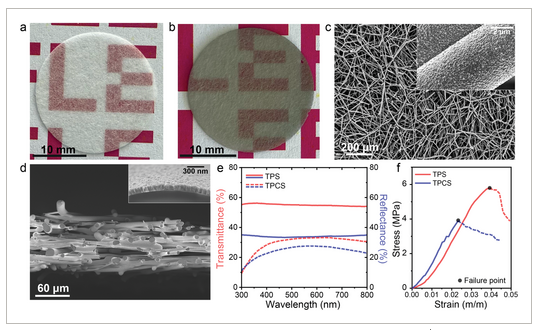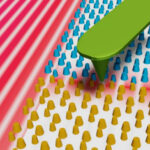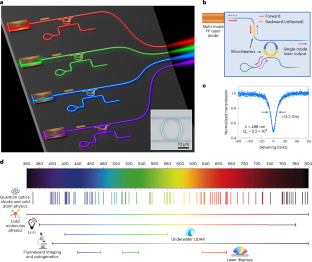EPFLの化学技術者たちは、透明で多孔質の新しい電極の上に、空気中の水分を採取して水素燃料に変換することができる、太陽光発電の人工葉を発明した。この半導体ベースの技術は、拡張性があり、調製が容易です。 EPFL chemical engineers have invented a solar-powered artificial leaf, built on a novel electrode which is transparent and porous, capable of harvesting water from the air for conversion into hydrogen fuel. The semiconductor-based technology is scalable and easy to prepare.
2023-01-04 スイス連邦工科大学ローザンヌ校(EPFL)
何が新しいのか?それは、透明で多孔質かつ導電性を有する新規なガス拡散電極であり、太陽光を利用して空気中のガス状態の水を水素燃料に変える技術を可能にしたのです。
植物の葉からヒントを得るーEPFLの技術者たちは、トヨタ自動車ヨーロッパと共同で、化石燃料を使わない再生可能な燃料の研究において、植物が空気中の二酸化炭素を利用して太陽光を化学エネルギーに変換する方法からヒントを得ました。植物は基本的に、環境から二酸化炭素と水を採取し、太陽光からエネルギーを得て、これらの分子を糖やでんぷんに変化させる。太陽光のエネルギーは、糖やでんぷんの内部に化学結合という形で蓄積される。
Sivula教授らが開発した透明なガス拡散電極は、集光半導体材料を塗布すると、まさに人工葉のように作用し、空気中の水と太陽光を吸収して水素ガスを発生させることができる。太陽光のエネルギーは、水素結合の形で蓄積される。
この研究では、太陽光に対して不透明な従来の層で電極を作るのではなく、フェルト状のガラス繊維でできた3次元のメッシュを基板として使用している。
透明なガス拡散電極を作るために、研究者たちはまず、石英(酸化ケイ素とも呼ばれる)繊維からなるグラスウールの一種を作り、高温で繊維同士を融着させてフェルト状のウエハーに加工する。次に、このウェーハに、優れた導電性、堅牢性、スケールアップの容易さで知られるフッ素ドープ酸化スズの透明薄膜をコーティングする。これにより、空気中の水分子との接触を高め、光子を通すのに不可欠な、透明で多孔質の導電性ウエハが完成する。次に、このウェーハに太陽光を吸収する半導体材料の薄膜を再びコーティングします。この2回目のコーティングでも光は通しますが、多孔質基材の表面積が大きいため、不透明に見えるのです。このコーティングを施したウエハーは、そのままでも、太陽光を当てれば、すでに水素燃料を生成することができる。
さらに研究者たちは、コーティングされたウェーハと、生成された水素ガスを測定用に分離するための膜を入れた小型のチャンバーを作りました。このチャンバーが湿度の高い状態で太陽光にさらされると、水素ガスが発生し、科学者たちが目指していた、太陽光による水素ガス生成のための透明なガス拡散電極のコンセプトが実現できることが示された。
研究者らは、今回のデモンストレーションで太陽熱から水素への変換効率を正式に調査したわけではありませんが、このプロトタイプとしては控えめで、現在のところ、液体ベースのPECセルで達成可能な効率よりも低いことを認めています。使用されている材料に基づくと、コーティングされたウェーハの太陽電池から水素への変換効率の理論値は最大12%ですが、液体電池では最大19%まで実証されています。
<関連情報>
- https://actu.epfl.ch/news/a-step-towards-solar-fuels-out-of-thin-air/
- https://onlinelibrary.wiley.com/doi/10.1002/adma.202208740
- https://pubs.acs.org/doi/10.1021/jacs.0c00126
気相光電気化学水素製造用透明多孔質導電性基材 Transparent Porous Conductive Substrates for Gas-Phase Photoelectrochemical Hydrogen Production
Marina Caretti, Elizaveta Mensi, Raluca-Ana Kessler, Linda Lazouni, Benjamin Goldman, Loï Carbone, Simon Nussbaum, Rebekah A. Wells, Hannah Johnson, Emeline Rideau, Jun-ho Yum, Kevin Sivula
Advanced Materials Published: 28 November 2022
DOI:https://doi.org/10.1002/adma.202208740
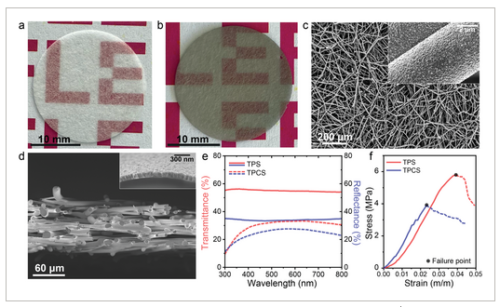
Abstract
Gas diffusion electrodes are essential components of common fuel and electrolysis cells but are typically made from graphitic carbon or metallic materials, which do not allow light transmittance and thus limit the development of gas-phase based photoelectrochemical devices. Herein, the simple and scalable preparation of F-doped SnO2 (FTO) coated SiO2 interconnected fiber felt substrates is reported. Using 2–5 µm diameter fibers at a loading of 4 mg cm−2, the resulting substrates have porosity of 90%, roughness factor of 15.8, and Young’s Modulus of 0.2 GPa. A 100 nm conformal coating of FTO via atmospheric chemical vapor deposition gives sheet resistivity of 20 ± 3 Ω sq−1 and loss of incident light of 41% at illumination wavelength of 550 nm. The coating of various semiconductors on the substrates is established including Fe2O3 (chemical bath deposition), CuSCN and Cu2O (electrodeposition), and conjugated polymers (dip coating), and liquid-phase photoelectrochemical performance commensurate with flat FTO substrates is confirmed. Finally, gas phase H2 production is demonstrated with a polymer semiconductor photocathode membrane assembly at 1-Sun photocurrent density on the order of 1 mA cm−2 and Faradaic efficiency of 40%.
太陽熱水素製造用有機半導体光電面の安定性の確立 Establishing Stability in Organic Semiconductor Photocathodes for Solar Hydrogen Production
Liang Yao, Néstor Guijarro, Florent Boudoire, Yongpeng Liu, Aiman Rahmanudin, Rebekah A. Wells, Arvindh Sekar, Han-Hee Cho, Jun-Ho Yum, Florian Le Forma, and Kevin Sivula
Journal of the American Chemical Society Published:April 9, 2020
DOI:https://doi.org/10.1021/jacs.0c00126
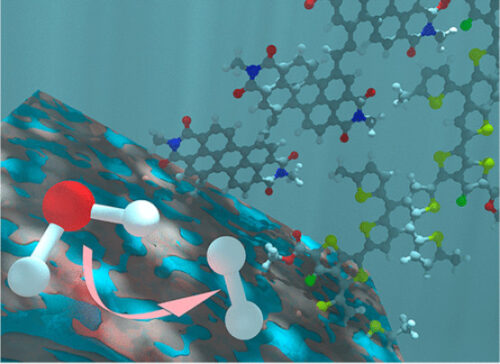
Abstract
As organic semiconductors attract increasing attention to application in the fields of bioelectronics and artificial photosynthesis, understanding the factors that determine their robust operation in direct contact with aqueous electrolytes becomes a critical task. Herein we uncover critical factors that influence the operational stability of donor:acceptor bulk heterojunction photocathodes for solar hydrogen production and significantly advance their performance under operational conditions. First, using the direct photoelectrochemical reduction of aqueous Eu3+ and impedance spectroscopy, we determine that replacing the commonly used fullerene-based electron acceptor with a perylene diimide-based polymer drastically increases operational stability and identify that limiting the photogenerated electron accumulation at the organic/water interface to values of ca. 100 nC cm–2 is required for stable operation (>12 h). These insights are extended to solar-driven hydrogen production using MoS3, MoP, or RuO2 water reduction catalyst overlayers where it is found that the catalyst morphology strongly affects performance due to differences in charge extraction. Optimized performance of bulk heterojunction photocathodes coated with a MoS3:MoP composite gave 1 Sun photocurrent density up to 8.7 mA cm–2 at 0 V vs RHE (pH 1). However, increased stability was gained with RuO2 where initial photocurrent density (>8 mA cm–2) deceased only 15% or 33% during continuous operation for 8 or 20 h, respectively, thus demonstrating unprecedented robustness without a protection layer. This performance represents a new benchmark for organic semiconductor photocathodes for solar fuel production and advances the understanding of stability criteria for organic semiconductor/water-junction-based devices.

